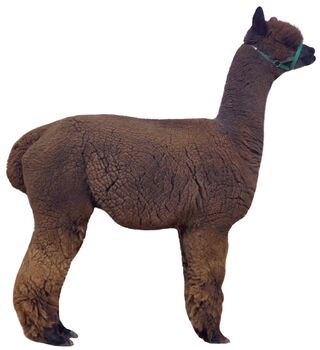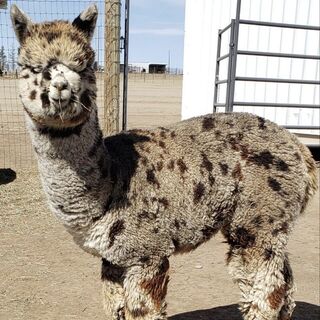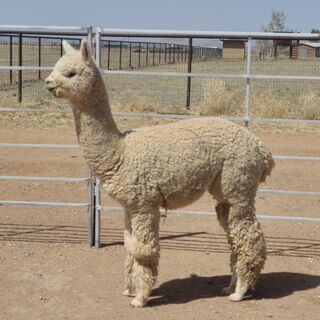POSTPARTUM CARE
POSTPARTUM CARE
Postpartum care for both your dam and cria are important. It is always best to know more in advance. One text has been recommended repeatedly as the best source of birthing information for Camelids:
https://www.useful-items.com/product-p/109nc.htm
After Birth Checklist
The afterbirth is wiped off with a clean towel. Pay attention especially to the feet as afterbirth that dries can compress their legs. Dams do not lick their babies clean or consume their afterbirth after it passes.
Everything is complete and normal: four legs and feet, nose is clear, and it is breathing normally, teeth erupted, eyes open and clear.
Determine if you have a male or female. Lift the tail and see if you have two openings, both an anus and a vulva. If yes, you have a girl. If only an anus is there then you have a boy. Inspect him to find his penis which is on his belly between his tail and umbilicus. Testicles appear later as they are not typically descended at birth.
Ensure that their rectal temperature is appropriate and normal: 100-102°. This is very important as below 98° will not allow the stomach to process any food properly. (Take steps to get the temperature up if below 99°.)
Check for a suckling reflex. Gently insert your little finger into the mouth of the cria and see if it latches on and sucks as if your finger was a teat.
Dip the umbilical navel in Nolvasan; the generic form is chlorhexadine 2%. It is not a prescription and does not sting like betadine or iodine. One vet we know has indicated that a test on calves has shown that 3-4 applications in the first 5-6 hours has proven helpful in keeping germs from being absorbed into the bloodstream via the umbilicus. You want it to dry up and fall off, so we do not recommend that you persist the treatment past one day unless symptoms indicate otherwise.
Give a CDT shot on the 2nd day as crias are born immunodeficient. The tetanus part of the vaccine will take 10 days to build an immunity in the cria.
Birth Defects
Windswept legs are an angular deformation that usually self-correct in two weeks. Have your vet consider a Bo-Se shot if your area and hay are lacking in selenium. And keep the consideration in mind that rickets is a possibility and may be treated with the appropriate vitamin D supplement.
We have had a couple of females born with a sealed vaginal vault we will start inspecting the opening in the vulva for a proper sized hole so that urine will be able to be properly eliminated. Inspect females regularly over the next two days to ensure that a bubble in the vulva that retains urine does not appear.
Observe the cria for other less severe issues such as legs or ankles not fully extended.
Be aware of possible fatal birth defects like choanal atresia, wry face, cleft palate, or potential deafness if you have a blue-eyed white.
Still Births
If you have a still birth leave it with the dam until she accepts the fact that it is no longer alive. It can be very difficult for them to accept. Consider freezing the dead cria for use in a hands-on neonatal class.
The old adage doesn’t assuage the pain of a still birth or birth defects, but it does ring true: if you have livestock eventually you will have deadstock.
Nursing
Waxy plugs form throughout late pregnancy on a dam’s teats. While they are not a good indication of imminent birth, they should be removed after birth. Just use your freshly washed fingertips to gently remove all four of them.
The alpaca udder has no teat cistern like a cow, horse, sheep, or goat. The cria suckles from teat to teat stimulating the mum to produce more milk. This is normal cria nursing behavior.
The First 24-72 Hours
Alpacas are born without antibodies. They obtain those from their dam when they nurse. The first expression of milk after birth is a thick, creamy substance. This is called colostrum. It contains all the important antibodies for the cria. The cria absorbs these through their stomach.
Crias need to consume adequate colostrum from their dams to ensure that they are adequately protected from pathogens in their environment.
Curiously enough, crias are born monogastric, i.e., their 3-chambered stomach is not yet fully developed.
The first 24 hours is very important—critical to their first 4-6 weeks health. Most of the dam’s antibodies are absorbed during this time. One vet that we use has indicated that the absorption window closes completely at 72 hours after the first introduction of liquid into their stomach. Another vet that we have utilized has indicated that the first 8-24 hours are when the large immunoglobulin molecules are absorbed in the cria’s stomach. So, where both vets agree is that the first day is the most important. In any event these antibodies will wear off in 4-6 weeks as they develop their own immunities.
IgG Test
Colostrum contains antibodies and adequacy of transfer of these antibodies in crias can be measured by an IgG test. It is best to test them between 24 and 48 hours of age. After 7 days of age antibody concentrations decline and it is more difficult to interpret the findings of the IgG test. The earlier days are better because the longer you leave it, the cria with Failure of Passive Transfer (FPT) is more likely to get sick and the result is less useful to you in terms of preventing sickness! This type of test is a camelid-specific test and does not measure antibodies acquired from bovine or any other species’ colostrum. This test can be quite expensive.
Intervention
While most crias will latch on to their mother’s teats quickly, you need to hang around and intervene. If the cria has not found the milk bar and started nursing within 2-4 hours, good postpartum care can mean that intervention is needed.
If you have a first-time dam that resists letting the cria latch on (finding the milk bar), tie her up on a lead, lift one front foot so she cannot kick, and have a second person assist as needed with the baby. You can also utilize an Alpaca chute. Nature usually takes over quickly.
Try dabbing some clear Karo syrup on her teats with a clean finger and on the cria’s tongue. Not too much though. You are getting it to associate the taste and the source. Also, the dab of syrup on the cria’s gums will give the cria a quick energy boost if it is lethargic.
Although it is easier with two people, one person can help guide a cria struggling to locate their dam’s teats. They have an instinct to go under their mom where it is darker. They may get confused and approach her breastbone so gently point the cria toward the dam’s teats in back. Most of the time the problem is twofold. They don’t turn their head quite enough to find the teats, and they go too far and end up on the other side of the dam.
Dams After Birthing
Dams should pass their placenta within 1-24 hours after giving birth. Don’t ever pull it out. Let gravity do its work. If it gets so long that she begins soon to walk on it use that shoestring from the cria kit to tie it up. Once it is out spread it out to make sure that it is intact without any holes in it. You don’t want anything left inside the dam. Then bag it up in a trash bag and dispose of it. Don’t let your LGD eat it!
If you have a dam that is slow to get her milk to let down, you might try using a warm compress on her teats and udder.
If the dam has not passed her placenta that could be a factor in her milk not coming in. Oxytocin can be administered to help a placenta pass if it’s been longer than 24 years.
If the dam has no milk and still has none after using the above methods, obtain some domperidone from your vet. This should help to bring her milk in. You may need more than one dose.
Dams will usually hum loudly and often when you are working with their cria. Some may spit at you so be prepared!
Milking
Let’s face it, most of us did not grow up on a farm milking cow. Your postpartum care responsibilities may include learning to milk an Alpaca dam. You may have to milk the dam and feed it to the cria if the cria absolutely cannot latch on. Use your clean fingers to move down the dam’s teat (1-2-3-4, and repeat) to express colostrum and catch it in cup or jar. Be very, very careful not to spill it. Dams can be jumpy and may kick or bump you spilling this liquid gold. You can use a needless syringe to get it into the Cria.
Expressing or milking isn’t too difficult. Start with your fingers and squeeze downward. You might find a YouTube video about manually milking a cow. The procedure is similar although on a much smaller scale.
Alpaca Colostrum Substitutes
Utilize the frozen goat colostrum from your freezer if the dam is still not making milk. Be sure to defrost it at room temperature. Do not use a microwave. Then warm it to the touch. Remember that a dam has a normal 100°-102° temperature. It will be warm. We have rarely needed it, but you must be prepared in advance as it may be a part of your postpartum care.
The last consideration would be to obtain and use Powdered Colostrum REPLACER (*not* SUBSTITUTE) from your local vet store. We have not gone this route, so we have no personal experience with which to testify concerning it.
If you must bottle feed use the Pritchard nipple and empty soft drink bottles to feed. Then just use regular whole milk from the store starting on day 4 after the colostrum absorption period has passed. It tastes most like their dam’s milk. It must be warmed but cannot be overheated. Using goats’ milk or other additional additives is not needed. We bought organic milk when we fed bottle babies.
We did find a video link to a good method of bottle feeding via syringe that is different from our method:
https://www.youtube.com/watch?v=pYUVbNwiqzE&feature=share
Bonding and Isolation
This is the easy part of postpartum care. When a cria is born it usually only needs just a relatively short amount of time isolated with the dam. Bonding time is most important as the cria begins its nursing attempts. After the cria has found the milk bar get them to the regular herd soon as the “Aunties” will help socialize the baby into herd life. If the baby is born in the pasture, that’s fine.
Isolating the dam too quickly may stress her. When the dam and cria are isolated be sure to provide good hay and water for the dam during this isolation time. It’s also best that the dam is able to see her pen-mates, so she doesn’t stress.
While you must do some handling after birth, try to keep it to a minimum. The baby needs to imprint on its dam, not a human. Don’t be afraid to do what is necessary postpartum care though. Picking up a baby to clean it off or weighing it will not result in an over-socialized Alpaca. Nor will helping it get to the milk bar. Just don’t sit there and cuddle it day after day after day.
Other Cria Considerations
If you have young crias they made need coats when the weather drops below 40°. Any age of animal may need them if they shiver. They are available online. Crias don’t have control over their body temperature like mature Alpacas. It takes a while for them to regulate it.
Watch crias carefully—most especially during the first week—as they can go down or septic quickly. They are especially susceptible to weather that is too cold or too hot. They should be up, moving about and nursing on a very regular basis.
Weigh the cria at the same time each day. It is normal for the cria to lose up to one pound on the first day of life. After that they should gain about .25 to .50 pounds per day. If not, then the cria is not getting enough milk. Inspect the dam’s teats to see if all are expressing milk. Consider getting an Rx for domperidone from your vet.
The first stool of any mammalian infant is called the merconium. It is important to watch for this to pass. It will be small and whiteish in color. Infrequently (some say more often, even being prone to constipation) a cria may have a slight bowel obstruction that can contribute to a lack of energy in the first day or two. If you are sure that it did not pass, then a small warm water enema is a standard treatment. Clear Karo Syrup (about 1-2 CC’s) also has a mild laxative effect. Also observe the cria to ensure that it is urinating normally.
If you have a new cria that suddenly starts acting off — trembling, not standing, not nursing — it could well be Sepsis, the cria needs a vet or vet hospital ASAP. It is doubtful that if you take it in the car to your regular vet that they will not have the needed plasma on hand. The state veterinary school is usually the only place equipped to handle this type of emergency. Crias has an extremely short timeline for getting this corrected. There’s nothing worse than seeing a baby under a few days old die. Speaking from experience unfortunately.
When shearing crias, DO NOT shear the crias tail. This is where mom recognizes her babies scent. She may reject the cria if tail is sheared.
Over-handling Concerns
Don’t over socialize all Alpacas, but especially MALE crias to avoid aberrant behavior/berserk male syndrome. This is where so many people err during their postpartum care practices. You want them to be approachable but not in your face friendly. There is a lot more to be said about this, but if you ignore this advice you may have to end up euthanizing the Alpaca. Basically, don’t allow them to do anything when they are small and cute that you wouldn’t want a full grown 150 lb. Alpaca to do. And don’t overly cuddle them they as are not a companion animal like a dog.
Correctable Birthing Issues
Good postpartum care may include correcting things that need to be fixed…
TENDONS—Contracted tendons can appear at birth or shortly thereafter as the cria gains mobility. The tendons are so tight that they usually cause the front legs to fold in at the ankle. The first reaction is to think you have a malformed cria. They can stand on the front side of their ankle. If left too long without correction they can do damage. Fortunately, they usually respond very well to physical therapy. Contact an experienced camelid veterinarian who can talk you through how to do it. Some cases may need splinting—but be very careful. Incorrect splinting can do significant harm to the cria. Banamine can be administered to help with the pain the cria is feeling.
EARS—There’s a funny saying about crias born with floppy/bent ears. “If you tape, they’ll be straight in 2 weeks; if you don’t it will take 14 days.”
While this is not a guarantee that most misshapen ears will self-correct, the idea is to give them a chance to do so. If they don’t self-correct within the first couple of weeks you could try carefully taping a tampon to the ear for a while. Be sure not to cut off the blood circulation when using vet wrap around it!
Sepsis Treatment
Sepsis is a life-threatening condition that arises when the cria’s response to infection causes injury to its own tissues and organs. In our experience it occurred in the first few weeks of the life of the cria. Monitor your crias closely during this time. The following information is from this link. Be sure to read it at the link to completely understand the abbreviations and medical instructions.
(From the Dr Pam Walker camelid drug formulary document:)
“3. Naxcel, Excenel (Ceftiofur – 50 mg/mL) – commonly used to treat neonatal sepsis, upper respiratory infection, pneumonia, retained placenta and uterine infections. Naxcel can be used IV or SC. If used IV, must be given BID. With severe infections and SC usage, can also use BID. Excenel has the same parent drug as Naxcel, just a different carrier that allows it to be kept at room temperature, with a long expiration date; it should be given only SC.
Dose: 2 mg/lb, SC, IV, SID to BID (1.0 mL/25 lbs, 4 mL/100 lbs)
HOWEVER, antibiotics alone are rarely enough to treat sepsis. Fluid therapy and plasma greatly increase chance of survival.”
Cria Neonatology
The following link contains some good information about cria neonatology. But a couple of items have been shown to be disproven or a better in-the-field procedure.
1) The cria does not get immunity from its dam that has had a a CDT vaccine late in pregnancy. In fact, this vaccine given to a pregnant dam late in its term has been shown to cause an abortion.
2) Plasma transfusions are faster and just as effective when given IP versus IV. Academic vets in teaching hospitals tend to have plenty of labor to help in an intravenous (IV) transfer which takes 2-3 times as long. If gravity (no impatience and pushing) is allowed to introduce the plasma, then the intraperitoneal (IP) is normally successful and safe.
A vet that we know, and trust posted online the following points for a successful plasma transfer:
It is essential to:
1) store the plasma correctly
2) thaw the plasma slowly and not overheat it
3) prep that area of the puncture with proper aseptic technique
4) position the cria correctly so the intestines fall away from the target area
5) use an indwelling catheter rather than a large bore needle inside the abdominal cavity
6) allow the plasma to enter the cavity passively by gravity flow.
If all these precautions are followed IP transfusions are very safe and successful.
Camelid Plasma Sources:
https://www.useful-items.com/product-p/plasma.htm
Plum Creek Alpaca's has plasma available in an emergency for our Arizona friends, if needed please replace it in a timely manner for the next person.
WEANING CRIAS https://www.plumcreekalpacas.com/page/10287/weaning-crias
Thank you for permissions to use this information. https://www.facebook.com/aubrey.oaks.alpacas
Thursday, January 11, 2024




